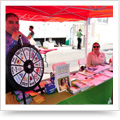How to Plan Your First Health Fair
Use this comprehensive list to make your community outreach a success.

“Me, plan a health fair? You must be kidding!”
That’s what I said when I was asked to organize our fitness facility’s first health fair. After 8 months of wrong turns, detours and far too much stress and drama, the big day came. Our first health fair was a hit! And we earned $1,000 for our designated charity!
No experience is necessary; I certainly had none. I did, however, break the first two rules of event planning: I did everything myself, and I spent my own money. To help you steer clear of these and other trial-and-error mistakes, I’ve organized my notes from the experience into a planning guide. If you take the role of manager and divide the details of the task among a team of coordinators, you’ll be on the road to a great community event.
The Manager’s Role
Here’s what you need to do to get this underway:
Spread the idea. Announce the event 6–8 months in advance. Get the staff and membership excited! Assemble a team of volunteer Coordinators (staff or members).
Make logistical decisions immediately. Set the date and time and find a venue, at least 6 months before the fair. Determine how many tables your venue will accommodate, and arrange to rent or borrow tables and chairs. Share all this information with your team.
Make your fair unique. Define your event—for example, “Spring Wellness Fest” or “Health and Fitness Expo.” Will you have health screeners, fitness demos, lectures, hands-on services, healthy food samples and games? Perhaps you will couple it with a 5K run or an open house.
Choose a charity that will receive most of the funds. Do not charge admission. Raffle ticket sales and table fees will go to the charity. Use sponsor money for fair operations.
Tell the Coordinators, beforehand, about any special requests or restrictions. For example: “I only want speakers from this hospital” or “No latex balloons.”
Trust your Coordinators to do their jobs, using the guidelines below. Answer their emails promptly, and meet with them occasionally to collect information. Maintain a folder for each of the planning areas.
Prepare three documents.
- Create a professional flier for promotion purposes.
- Develop an agenda, and update it 1 month before the event. Include the timetable for the demos, lectures and mini-classes; a list of sponsors and vendors; and a facility map.
- At 1 week before the event, make a table layout map that shows vendor locations. When assigning tables, include any special considerations, such as the need for an electrical outlet.
The Role of the Coordinators
Divide up the following tasks among your team members:
Find sponsors. Locate businesses that are willing to donate money. The Manager designates how the funds will be used.
- On your facility’s letterhead, write a letter explaining the event and the designated charity. Include your company’s tax ID, nonprofit status and contact information. Describe how sponsors will be acknowledged.
- Visit potential sponsors in person. At this point in the process, emails and letters are easily ignored. Be brief: “We are having a health fair to raise money for this charity, and we hope you can sponsor us with a donation of $25 or more.”
- Start with local places where you and your organization are known: stores, supermarkets, banks, medical offices, women’s clubs, restaurants, etc. Then branch out: Visit every establishment at a shopping center or business park. Stay within a 5-mile radius of your venue.
Note: Some potential sponsors will give you an immediate response; others will not. Do not approach them more than once. If you do not hear back, the answer was no.
Find vendors and health screeners. Strike a balance of vendors and health screeners. Get started on this 6 months before the fair.
- Compose a letter for vendors. Include the nonrefundable table fee amount ($25–$50), the fee deadline (2 months before the event) and the late-fee charge ($10). Nonprofit vendors (the American Heart Association, for example) may ask that the fee be waived.
- Create a sign-up form. Keep good records that include contact information and date of payment. You may need to remind some vendors of the deadline.
- Contact vendors directly. Most vendors and health screeners are eager to promote their businesses or services and will respond positively. Don’t forget food vendors!
- Cover these areas of health screening: blood pressure, blood glucose, body mass index, blood oxygen, and eye, vein and spinal health. Make a special card that attendees can use to write down their results.
- Once your table quota has been met, start a waiting list. There are always last-minute dropouts.
- Communicate with everyone 1 month before the fair and again 1 week before the fair. Immediately after the event, send thank-you notes or emails.
Plan the lectures. Schedule one 20-minute lecture per hour on topics such as nutrition and heart health.
- Find and confirm speakers 3–6 months before the fair. Reconfirm with your speakers a month before and a week before.
- Coordinate the lecture times so they don’t conflict with the mini-classes.
- Determine where the lectures will be held. Plan for 20 chairs and a projector for showing PowerPoints.
- On fair day, introduce the speakers, stay to listen to their presentations, and thank them when they finish. Remember that they are doing this for free. Send each of them a thank-you letter or email afterward.
Set up the mini-classes. Schedule one 20-minute mini-class per hour.
- Find instructors, and schedule mini-classes on a wide variety of topics.
- Determine where the classes will be held. On fair day, make sure all equipment and props are on hand. Hang a sign at the door or demonstration area, and make announcements in the vendors’ area.
- Reconfirm with instructors 1 month and 1 week before the fair.
- If staff shirts are available, ask instructors to wear them.
- After the fair, return equipment and send a thank-you email to the instructors who volunteered.
Organize the welcome table. Attendees should be warmly greeted! Offer gift bags, agendas, health screening cards and free health-related pamphlets.
- Write or email the American Heart Association, the Cancer Society, the Health Department, etc., 6 months before the event to request free brochures.
- Ask medical offices and other health/wellness businesses (if they are not already vendors) for brochures.
- A few months before the fair, use sponsor money to purchase 250 or more gift bags that attendees can use to collect free items.
- Find volunteers to sit at the welcome table (in shifts).
- At the end of the fair, pack up unused materials and save them for next year.
Plan a table to advertise your facility. Share information about your own facility, especially with nonmembers.
- Ask a supermarket to donate bottled water.
- Find volunteers to staff this table.
- Place your facility’s flier, class schedule and free class passes on your table.
- Sell T-shirts or other related items (we sold cookbooks left over from another fundraiser).
Decorate. Create an atmosphere for your event. Pick a theme color.
- Buy matching tablecloths.
- Buy or make other decorations. We made swag curtains out of plastic tablecloths and hung them over the doorways.
- Decorate inside and outside the venue.
Organize the raffle. Create three raffle baskets, or acquire gift cards worth $25 or more.
- In person, ask restaurants, supermarkets and other stores to donate a gift card for the raffle. Give them a flier, your contact information and your tax exempt number (if applicable).
- Write to the national headquarters of chains or larger stores, such as Macy’s or Bed Bath & Beyond. Follow the directions on their websites for submitting donation requests. These usually take 6 months to process.
- Find local businesses that will make a complete basket for you (my hairdresser did this). Incorporate the theme color when wrapping baskets, and label each one.
- Purchase raffle tickets (dollar stores have them) and a money box.
- Presell raffle tickets by displaying the prize baskets at your facility, starting 2 weeks before the event. We made $250 doing this!
- On fair day, set up your table in a prominent place, such as by the free food table.
- Afterward, send thank-you notes or emails to the contributors and call winners.
Your first health fair doesn’t have to be the nerve-racking experience it was for me. You don’t have to break the bank or fly solo. Use this down-to-earth, hard-earned advice to plan a fun experience you’ll want to repeat.
Are you a club owner or manager? Gain, train and retain world class staff with the fastest growing health club software in the world: https://www.ideafit.com/clubconnect
You put a lot of time and effort into planning your first health fair. Here are some tips to spread the word.
- Use the Internet. Create a health fair website, and continually update it. Put a link on your establishment’s website, and share it on social media. Ask members, sponsors and vendors to put it on their websites or social media.
- To save money on signage, ask local printing establishments if they would donate their services or a few reams of paper. Hang signs in your facility and other businesses within a 5-mile radius 3 weeks before the fair. Always ask permission before hanging signs.
- Ask sponsors and vendors to help you advertise.
- Use an online template to write a press release. Send it to newspapers 1 month or more before the event.
- Ask to be interviewed by a local radio station.
Jean Carl1
Jean Carl, an Iyengar style yoga teacher has been with the YMCA for 25 years, teaching or subbing for everything from Aquacize to Zumba. After serving 33 years as a Pennsylvania public school music teacher, she now devotes herself to the YMCA's yoga and Les Mill BodyVive classes. Every one of her article has been based on her real life experinces as a longtime fitness professional and came from a desire to share ideas with other instructors and managers. She has also been published in SHAPE, FLOWYOGA and YOGA: BODY MIND AND SPIRIT. Her, as yet unpublished book, is for children and called THE YOGA FAMILY; A LIZARD'S TALE. Biggest accomplishment: Overcoming breast cancer





